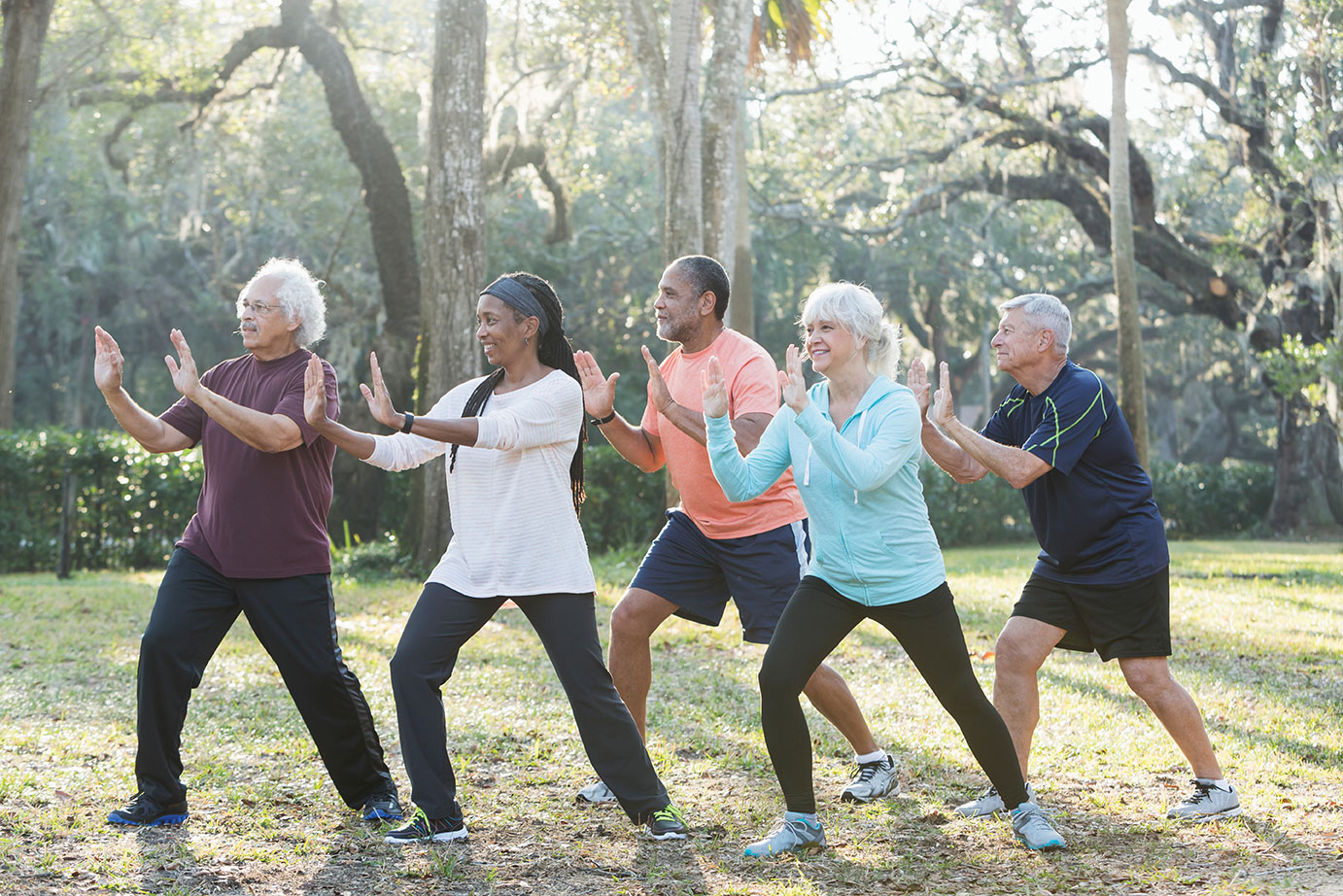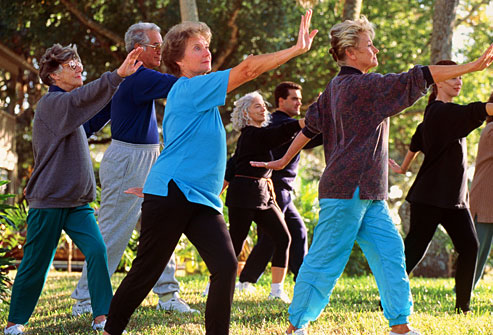https://cdn.steemitimages.com/DQmaGvuMHWzDycyVtqxygovbASdmwivqUfjtBKnbM99it3J/Tai-Chi-Web.jpg
# The human experience is rife with health concerns which continue to baffle medical professionals throughout history. ___ Medical issues arise in certain individuals which tend not to fit in the typical characterized boxes of commonly defined diseases. Treating something that is difficult to define becomes extraordinarily challenging. Fibromyalgia is one such disorder which researchers have found to have fallen outside the reach of in depth understanding. Fibromyalgia is defined by chronic widespread musculoskeletal pain, fatigue, sleep disturbance, and prominent physical and psychological impairment, causing substantial and increasing healthcare costs.¹ There are currently no laboratory diagnostic tests for Fibromyalgia, but neuroendocrinologic changes in the central and peripheral nervous system is currently the most commonly held view for causality.¹ No cure for fibromyalgia exists at this time; however, treatments employ an integrative approach including drugs, exercise, cognitive behavioral therapy, and health education.¹ ___ ### Drug interventions are generally either analgesic or antiepileptic in nature, neither of which have been shown to generate long term, sustainable benefits.¹ ___ Fibromyalgia patients using opioid analgesics also run a high risk of developing drug dependencies and overdoses.¹ Opioid prescription for fibromyalgia patients continues despite the growing body of evidence correlating it with poorer health outcomes than fibromyalgia patients not using opioids.¹ Pharmaceutical interventions are undoubtedly inadequate in restoring quality of life for patients with fibromyalgia. ___ ## Research is continuing to show the exponential benefits of exercise for both healthy and recovering individuals, and is currently an integral part of the fibromyalgia treatment plan.¹ ___ Standard care for fibromyalgia patients includes moderate aerobic exercise; however, numerous patients often find it difficult to maintain exercise regimens due to fluctuations in symptom expression (flare-ups).¹Health professionals clearly need to renovate exercise programs for fibromyalgia patients in order to reduce chronic musculoskeletal pain and improve their physical and psychological functioning and quality of life.¹ Chechen Wang, director of medicine at Tufts University of Medicine, et al., set out to test a new approach to treat fibromyalgia, in regards to exercise, in their study, “Effect of tai chi versus aerobic exercise for fibromyalgia: comparative effectiveness randomized controlled trial.” ___

[Source](http://www.goodwinhouse.org/) ___ # The purpose of this study was to ascertain the effectiveness of tai chi compared to the standard treatment in patients with fibromyalgia, aerobic exercise.¹ ___ Researchers also aimed to determine whether the effectiveness of tai chi depended on frequency or duration (dosage).¹ This 52 week study included 226 adults, aged 21 and older, with fibromyalgia (as defined by the American College of Rheumatology 1990 and 2010 criteria), who were assigned to either one of four classic Yang style tai chi treatment groups (151) or to an aerobic exercise group.¹ The four tai chi groups were divided into either once or twice a week, and either 12 or 24 weeks.¹ Participants were strongly encouraged to maintain their practices throughout the week in accordance to their weekly assignments.¹ Aerobic and tai chi groups ran concurrently to control for the variables of weather and concomitant symptom flare up which might otherwise confound the data.¹ Three recruited tai chi instructors were rotated through each group to determine whether results were affected by variance in instructors.¹ ___ ### Researchers’ primary outcome measure was the change from baseline to 24 weeks in the revised fibromyalgia impact questionnaire (FIQR). ___ According to the article, “The FIQR is a well validated multidimensional instrument that measures participant rated overall severity of fibromyalgia, including intensity of pain, physical function, fatigue, morning tiredness, depression, anxiety, job difficulty, and overall wellbeing.”¹ Secondary measures included changes of scores in patient’s global assessment of functionality, anxiety, depression, self-efficacy, coping strategies, physical functional performance, functional limitation, sleep, and health related quality of life.¹ Secondary outcomes were measured using a visual analog scale for global assessment; the hospital anxiety and depression scale (HADS); the arthritis self-efficacy scale; the Pittsburg sleep quality index; physical/mental short form health survey summary scores; symptom severity scale score; Beck depression inventory II; coping strategies score; social support survey; improved health assessment questionnaire; outcome expectations scale; the community health activities model program for seniors (CHAMPS) physical activity questionnaire for older adults; and health assessment questionnaire.¹ Physical function was assessed with the chair stand, six minute walk, and balance tests.¹ Muscle strength and power were measured using a leg press.¹ All secondary outcomes were measured at 12, 24, and 52 weeks.¹ ___ ### Participants who were assigned to the classic Yang style tai chi intervention either had once or twice a week 60-minute classes, for 12 or 24 weeks.¹ ___ Participants were encouraged to employ at least 30 minutes of tai chi in their daily regimen during the length of the study and were asked to continue exercise after the study.¹ Printed materials providing information on the importance of physical activity and home practice were distributed to each of the tai chi and aerobic groups.¹ Participants in the tai chi group received printed materials describing tai chi principles, techniques, and safety precautions specific to fibromyalgia.¹ The first session was an explanatory session on theory and procedures, with the remaining sessions including a warm-up and review of tai chi principles, meditative movements, breathing exercises, and various relaxation techniques.¹ ___ ### The aerobic exercise group received a closely supervised program in group format with cardiovascular exercise in accordance to the current recommended guidelines for moderate intensity exercises for fibromyalgia.¹ ___

[Source](http://www.indiatvnews.com/lifestyle/news-regular-aerobic-exercise-may-ward-off-memory-loss-in-older-adults-claims-study-353754) ___ Each session consisted of an active warm-up with low intensity movements and dynamic stretching; choreographed aerobic training, progressing gradually from low to moderate intensity; and a cool-down with low intensity movements, and dynamic and static stretching.¹ The first session consisted of a 15 minute warm-up, 20 minutes of aerobic training, and a 25 minute cool down.¹ The aerobic training time was increased by 5 minutes every two weeks so that training was 40 minutes long by weeks 10-12.¹ Participants were instructed to walk daily and encouraged to increase their time until they reached 30 minutes a day.¹ ___ # Previous studies have shown that exercise is vital to maintaining quality of life in patients with fibromyalgia, and the results for this study are similar.¹ ___ Primary and secondary outcome measures showed clinically significant changes in all treatment groups, with the combined tai chi groups showing significantly greater outcomes in several measured areas.¹ Wang, et al., state in their article: >Compared with baseline, FIQR scores improved for participants in all five treatment groups at each follow-up. Generally, participants who undertook tai chi improved at all times on other outcomes as well, whereas participants who undertook aerobic exercise showed less improvement. At 24 weeks the combined tai chi groups improved significantly more than the aerobic exercise group in FIQR scores…In addition, all groups (tai chi and aerobic exercise) improved by more than the minimal clinically important difference compared with baseline.¹ All groups did show statistically significant changes in both primary and secondary outcomes; however, according to the authors, “In general…secondary outcomes favored tai chi compared with aerobic exercise, although the effects were not statistically significant.” These effects were lessened and nonsignificant after measurement at 52 weeks.¹ Results did vary within the tai chi treatments with greater changes in primary and secondary outcome measurements occurring more in the 24 week treatment group than in the 12 week group.¹ No significant differences were measured in the changes for frequency (once/twice a week).¹ A clear link between dosage and benefits received can be drawn from these results. ___ ## Some limitations that were experienced in this study were that it is quite difficult to blind researchers and participants of the interventions being studied, and that patients missed many of the classes and follow-ups.¹ ___ Placebo/nocebo effects were mitigated as best as possible by informing the participants that the study was researching the effect of exercise without emphasizing tai chi specifically.¹ Researchers hoped that this might reduce any previously held biases towards the intervention.¹ Researchers employed different algebraic functions in order to account for patients who missed sessions and follow-ups, but also recognized the attendance as a part of the intervention as discontinuation of appointments is characteristic of those with chronic pain disorders.¹ More patients missed sessions/follow-ups in the aerobic exercise group than in the tai chi group.¹ ___

[Source](http://www.webmd.com/arthritis/ss/slideshow-active-living) ___ # Tai chi integrates exercise and meditation in order to improve one’s physical and psychological wellbeing.¹ ___ This type of exercise, when modified to work for impaired patients, can significantly improve one’s quality of life in many different aspects.¹ Fibromyalgia is a complex neurological disorder which impairs physical functionality and psychosocial cognition.¹ Studies such as this one conducted by Wang, et al., help to embolden the small body of literature supporting mind-body interventions in individuals with chronic pain disorders, such as fibromyalgia. Clearly more research is necessary to fully support a new approach to managing chronic pain, but one cannot deny the potential benefits one might receive from mind-body medicine. ___ # Citation ___ ¹Wang, Chenchen, et al. “Effect of Tai Chi versus Aerobic Exercise for Fibromyalgia: Comparative Effectiveness Randomized Controlled Trial.” Bmj, 2018, doi:10.1136/bmj.k851. *Note: I have access to this article through the NUNM library. If anyone is interested in reading the text let me know and I will find a way to upload it.* ___


#
LOVELAUGHTER&&XHAOS
*PALPABLE POPE Ypyskypo Skwyrl, the Y's Cat-herder aka Chief Bigstick
High Priest, Church of Erin Erisian Ataxia Troupe : Caste of the Black Star*
https://steemimg.com/images/2016/09/22/YpyskypoSkwyrlVerified9e2f2.png

Originally posted here: https://steemit.com/steemstem/@alchemage/a-review-of-a-double-blind-comparative-study-of-aerobic-exercise-versus-tai-chi-in-managing-symptoms-in-patients-with





No comments:
Post a Comment